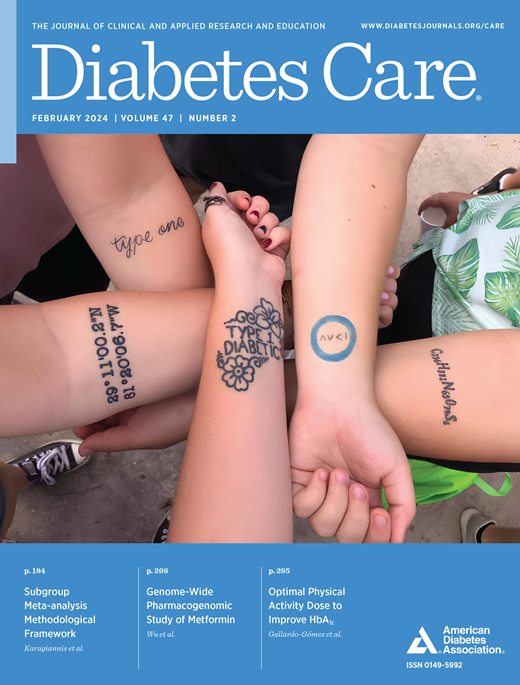Diabetes, Subclinical Myocardial Injury or Stress and Risk of Heart Failure Subtypes: The Jackson Heart Study
IF 14.8
1区 医学
Q1 ENDOCRINOLOGY & METABOLISM
引用次数: 0
Abstract
OBJECTIVE To assess the extent to which the concomitant presence of subclinical myocardial injury or stress and diabetes affects the risk of heart failure (HF) subtypes. RESEARCH DESIGN AND METHODS The Jackson Heart Study included Black adults, categorized based on diabetes status, high-sensitivity cardiac troponin I (hs-cTnI), and brain natriuretic peptide (BNP) levels. Subclinical myocardial injury was defined as hs-cTnI ≥4 ng/L in women and ≥6 ng/L in men, and subclinical myocardial stress as BNP ≥35 pg/mL. The study outcomes included incident HF, HF with preserved ejection fraction (HFpEF), and HF with reduced ejection fraction (HFrEF). RESULTS Among 3,484 participants (mean age 54.6 years, 63.2% women, 22.3% with diabetes, 26.4% with subclinical myocardial injury, 9.4% with subclinical myocardial stress), 306 developed HF (151 HFpEF and 139 HFrEF) over 12 years. Compared with individuals with no diabetes and no subclinical myocardial injury at recruitment, participants with diabetes and subclinical myocardial injury had a higher HF risk (hazard ratio [HR] 3.84, 95% CI 2.60–5.66), HFpEF (HR 3.68, 95% CI 2.13–6.36), and HFrEF (HR 4.26, 95% CI 2.40–7.53). The HRs associated with the presence of diabetes and subclinical myocardial stress versus their joint absence were 4.03 (95% CI 2.50–6.51), 5.71 (95% CI 3.11–10.47), and 2.13 (95% CI 0.88–5.17) for HF, HFpEF, and HFrEF, respectively. There was no significant diabetes status and cardiac biomarkers interaction. CONCLUSIONS Both diabetes and subclinical myocardial damage significantly increase the risk of all HF types among Black individuals.糖尿病、亚临床心肌损伤或应激和心衰亚型风险:杰克逊心脏研究
目的评估亚临床心肌损伤或应激和糖尿病同时存在对心衰(HF)亚型风险的影响程度。研究设计和方法Jackson心脏研究纳入黑人成人,根据糖尿病状态、高敏感性心肌肌钙蛋白I (hs-cTnI)和脑钠肽(BNP)水平进行分类。亚临床心肌损伤定义为女性hs-cTnI≥4 ng/L,男性≥6 ng/L;亚临床心肌应激定义为BNP≥35 pg/mL。研究结果包括突发HF、保留射血分数的HF (HFpEF)和降低射血分数的HF (HFrEF)。在3,484名参与者中(平均年龄54.6岁,63.2%为女性,22.3%患有糖尿病,26.4%患有亚临床心肌损伤,9.4%患有亚临床心肌应激),306名参与者在12年内发生HF(151例HFpEF和139例HFrEF)。与招募时无糖尿病和无亚临床心肌损伤的个体相比,糖尿病和亚临床心肌损伤的参与者有更高的HF风险(危险比[HR] 3.84, 95% CI 2.60-5.66), HFpEF (HR 3.68, 95% CI 2.13-6.36)和HFrEF (HR 4.26, 95% CI 2.40-7.53)。在HF、HFpEF和HFrEF中,糖尿病和亚临床心肌压力与关节缺失相关的hr分别为4.03 (95% CI 2.50-6.51)、5.71 (95% CI 3.11-10.47)和2.13 (95% CI 0.88-5.17)。没有明显的糖尿病状态和心脏生物标志物相互作用。结论:糖尿病和亚临床心肌损伤均显著增加黑人发生所有HF类型的风险。
本文章由计算机程序翻译,如有差异,请以英文原文为准。
求助全文
约1分钟内获得全文
求助全文
来源期刊

Diabetes Care
医学-内分泌学与代谢
CiteScore
27.80
自引率
4.90%
发文量
449
审稿时长
1 months
期刊介绍:
The journal's overarching mission can be captured by the simple word "Care," reflecting its commitment to enhancing patient well-being. Diabetes Care aims to support better patient care by addressing the comprehensive needs of healthcare professionals dedicated to managing diabetes.
Diabetes Care serves as a valuable resource for healthcare practitioners, aiming to advance knowledge, foster research, and improve diabetes management. The journal publishes original research across various categories, including Clinical Care, Education, Nutrition, Psychosocial Research, Epidemiology, Health Services Research, Emerging Treatments and Technologies, Pathophysiology, Complications, and Cardiovascular and Metabolic Risk. Additionally, Diabetes Care features ADA statements, consensus reports, review articles, letters to the editor, and health/medical news, appealing to a diverse audience of physicians, researchers, psychologists, educators, and other healthcare professionals.
 求助内容:
求助内容: 应助结果提醒方式:
应助结果提醒方式:


